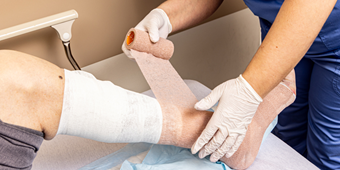First Steps To Take After Being Diagnosed With Diabetes

Find Your Perfect Match
Answer a few questions and we'll provide you with a list of primary care providers that best fit your needs.
If you have recently been diagnosed with type 2 diabetes, it might seem like a lot of information to juggle. Taking disease management one step at a time can help make everything seem less overwhelming.
Eating Right
Making healthy food choices and learning to have balanced meals is a major part of managing your diabetes.
The American Diabetes Association (ADA) provides the following tips to help people with diabetes choose which foods to eat and which to avoid:
- Dairy. It’s important to keep dairy in your diet for strong bones, but make sure to look for fat-free, low-fat, or non-fat options. The best dairy choices are fat-free or low-fat (1 percent) milk, plain non-fat yogurt (regular or Greek), non-fat light yogurt (regular or Greek), and unflavored fortified soy milk.
- Drinks. Beverages can drastically, and quickly, affect your weight and blood glucose level because of the amount of sugar contained in some of them. Choosing zero-calorie and low-calorie drinks, such as water, unsweetened tea, coffee, and diet soda, is your best option. Avoid super sugary drinks like regular sodas, energy drinks, sweet tea, fruit punch, and some other juices. If you get tired of water, try changing it up by adding lime, lemon, or other fruits.
- Fruits. Fruits low in sugar are good for you such as apples, peaches, strawberries, and blueberries. Fruits naturally high in sugar that taste sweet should be avoided such as oranges, grapes, and tropical fruits like bananas, pineapple, cantaloupe, and kiwi. Grapefruit should be avoided because it interferes with most cholesterol medications.
- Grains and starchy vegetables. Pick whole grains because they are the most nutritious. If you’re going to eat a starchy food, avoid those that are flour-based and have added sugar. Good options include whole wheat flour, brown rice, quinoa, popcorn, whole oats/oatmeal, corn, green peas, potato, lentils, and fat-free refried beans. Make sure, however, to limit your intake of grains and starchy vegetables so you don’t overdo your carbohydrates.
- Non-starchy vegetables. These can be a go-to food. Try to eat at least three to five servings a day, but the more the better because they have so few calories and carbohydrates. Do remember to choose “low sodium” or “no salt” options when using frozen or canned vegetables. Just a few of the many common non-starchy options include asparagus, green beans, broccoli, carrots, celery, mushrooms, onions, tomato, and zucchini.
- Proteins. Choose protein foods that are low in saturated fats and higher in omega 3 fats. Good protein food choices include dried beans, nuts, nut butters, tuna, herring, trout, tilapia, salmon, clams, crab, lobster, shrimp, chicken, eggs, pork tenderloin, beef chuck, beef flank, and organ meats.
Once you get used to eating a healthy diet, you’ll see how many options you have to still enjoy meals and snacks that you love.
Taking Prescribed Medications
There are various types of medications that your doctor could prescribe to help keep your blood glucose level in check when you have diabetes.
People with diabetes could have to take only insulin or both insulin and pills, depending on their personal condition.
If your doctor recommends you start a new diabetes medication, ask the following questions:
- Do I need to eat when I take my pills? If so, what?
- How many pills do I take?
- How often do I take the pills?
- What if I don’t remember to take my medicine on time?
- What side effects could I have?
- Will I take this medicine for the rest of my life?
- Will my diabetes medicine have a bad interaction with any other medications I take?
Just like with any medicine, make sure to follow the directions your doctor gives you and do not stop taking it without your doctor’s approval.
Keeping Doctor’s Appointments
Making and going to your doctor’s appointments is another important part of your diabetes care and management.
If you feel confident with the diabetes care your family doctor provides, stick with him or her. But, if you’re looking for someone else, do your research and determine what is important to you, such as gender, medical background, and hospital affiliation.
You and your doctor should be a team in managing your diabetes. You need to make going to your appointments a priority because your doctor can help you monitor whether your medications are working and answer any questions you have about your medicine, eating habits, or anything else about managing your diabetes.
Find Your Perfect Match
Answer a few questions and we'll provide you with a list of primary care providers that best fit your needs.
Source: American Diabetes Association




